Acne is a recurring issue in many adolescents and young adults, though it affects people of all ages.
It is a persistent condition that occurs when the hair follicles become plugged with white blood cells, dead skin cells, bacteria, and sebum.
Depending on its severity, acne can cause scarring of the skin and emotional stress, and low self-confidence. While effective treatments are widely available, acne can be very persistent and heals slowly.
It often causes whiteheads, blackheads, pustules, and papules and while it typically appears on the face, it can also affect the chest, back, shoulders, buttocks, and legs.
There are different types of acne and each type is distinct and requires special treatments. Therefore it is crucial to know what type of blemishes you are dealing with to treat the problem correctly.
The 8 Different Types of Acne (& How To Treat Them)
- Blackheads
- Whiteheads
- Papules
- Pustules
- Acne Mechanica
- Nodules
- Cysts
- Acne Conglobata
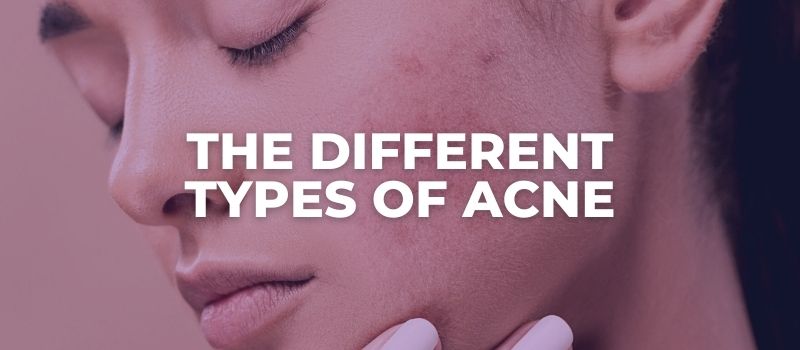
1. Blackheads
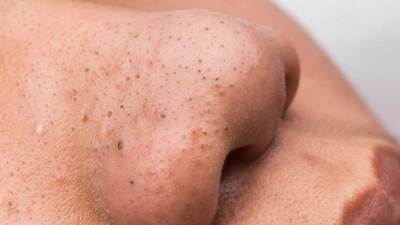
Blackheads are also called open comedones and they are the most common type of mild, non-inflammatory acne everyone gets from time to time.
They are small, raised bumps with a black tip.
Blackheads are plugs sebum, the buildup of dead skin cells, and bacteria.
They are open and widened, so when the contents in the follicle are exposed to air oxidation occurs, which makes them dark in color.
2. Whiteheads
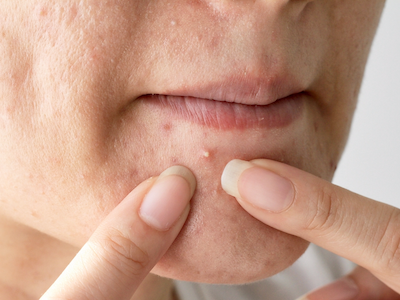
Whiteheads (also called closed comedones) and are small, white spots or bumps that stay closed at the surface of the skin.
This happens when the hair follicle is clogged from opening by the build-up of sebum and dead skin cells that stay trapped inside and raise a small, white-colored lump on the surface of the skin.
Whiteheads along with blackheads are mild and non-inflammatory acne lesions which typically do not cause scarring and are relatively easy to treat with a number of options.
There is a huge number of over-the-counter products that can help treat non-inflammatory acne blemishes.
They are sold in the forms of cleansers, gels, toners, moisturizers, and special creams that help dissolve the build-up of sebum and dead skin cells inside the follicle.
These products contain a mix of active ingredients and here are a few of them that have shown effectiveness in treating this type of acne:
Many home care remedies can decrease the appearance of blackheads and whiteheads such as:
- Avoid over washing and further irritating the skin
- Avoid using harsh products with a high alcohol content
- Focus on eating a healthy and balanced diet
- Keep yourself hydrated
- Limit sun exposure
- Do not pick, scratch or try to pop blackheads and whiteheads
3. Papules
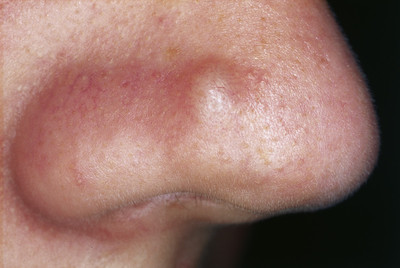
Papules are a small, superficial, raised area of the skin with the skin around the papule usually appearing slightly swollen and red.
They are solid, tender and lacking in fluid.
Papules do not have a visible center and the pores of the papule are not widened. They are classified as mild to moderate inflammatory acne lesions that develop when whiteheads and blackheads cause irritation and damage the surrounding skin.
The damage leads to mild to moderate inflammation and picking or trying to squeeze a papule can further aggravate the inflammation and lead to scarring.
4. Pustules
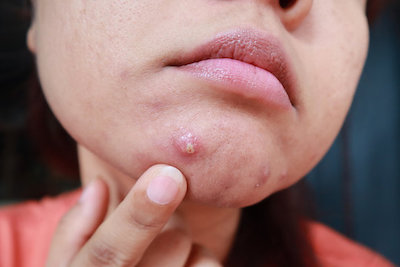
Or most commonly known as pimples are papules that develop at the mouth of the hair follicle and they usually look like much larger and inflamed whiteheads.
They are classified as mild to moderate inflammatory acne lesions and they become purulent in the center when infected with bacteria.
White blood cells, dead skin cells, and bacterial cells form this pus and this type of acne are almost always surrounded by red and inflamed skin.
5. Acne Mechanica
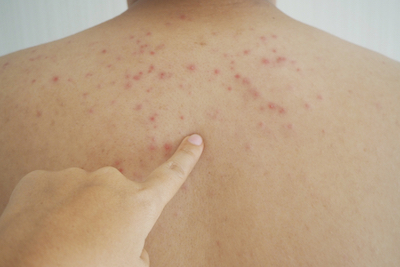
Acne mechanica is a mild skin condition that can develop anywhere on the face or body if a person is already prone to breakouts.
It is especially common in adolescents, athletes, construction workers, soldiers as it is typically triggered by excess heat, pressure, friction or rubbing of the skin.
Its appearance varies from small comedones to mildly inflamed papules and pustules. It is easy to treat in its early stages, but if it is left to progress, these mild breakouts can become rapidly irritated and turn into more prominent, inflamed blemishes.
How To Treat Acne Mechanica?
Mild to moderate inflammatory acne can be a bigger challenge than treating whiteheads and blackheads. These usually require stronger percentages of topically applied creams.
Some topical agents that can improve these conditions are:
- Salicylic acid
- Benzoyl peroxide
- Retinoids
- Topical antibiotics
Depending on the severity of your acne concern, your dermatologist might recommend oral medications such as:
- Antibiotics
- Birth control pills
- Anti-androgen agents
Some home remedies can also help treat and relieve some of the symptoms of mild to moderate papules and pustules.
Pay attention to the following tips:
- Apply a warm compress to the affected area to soften and encourage trapped bacteria and debris to rise to the surface of your skin
- Wash the affected area with cool water to relieve symptoms of inflammation
- Wash your hands before washing your face
- Do not pick or try to squeeze – this type of bacteria can easily spread to the surrounding area
- Use tissues to gently pat your face after washing
- Avoid spreading acne bacteria on towels
6. Nodules
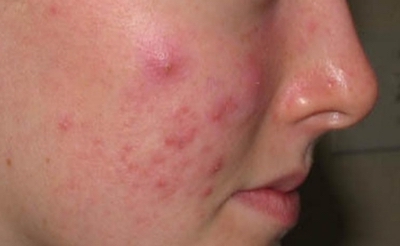
Nodules are large and inflamed lumps that feel firm to the touch and are located deep within the skin. They are painful and look like larger papules that have no visible center.
These are one of the most severe forms of acne that are not always red but they can appear like your normal skin tone or mildly bruised bumps.
Nodular acne usually needs a more intensive treatment as over-the-counter products are not powerful enough to clear them up.
Antibiotics and other oral medications can be prescribed as this severe form of acne blemish can cause further skin complications such as dark spots and scar. It is always recommendable to seek medical attention when faced with this type of inflammatory condition.
Cystic acne lesions are very large and soft lumps situated deep in the skin. They are filled with pus and can be very painful.
Cysts form deeper within the skin than nodules and are classified as the most severe type of acne blemishes. Hormonal changes can be the main trigger that leads to infection and severe inflammation inside the skin.
This type of severe inflammatory acne lesions can cause further complications such as scarring if not treated adequately.
8. Acne Conglobata
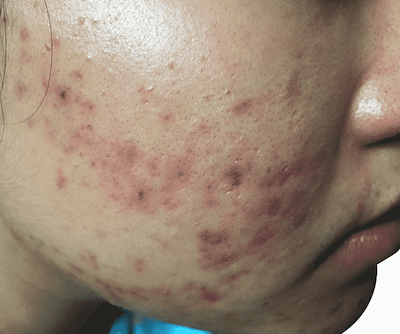
Acne conglobata is a rare but probably the most severe combination of several acne types that interconnect with each other.
It occurs when cysts and nodules begin to grow together deep inside the skin and it is classified as a severe form of nodulocystic acne.
The cysts often contain purulent and foul-smelling discharge and this condition may occur on the face, chest, back, upper arms, buttocks, and thighs.
This condition may occur gradually following the sudden worsening of pustular acne breakouts that have been quiet for a long period of time.
Acne conglobata is a serious condition that requires immediate medical attention as it can cause significant scarring and skin disfiguration over time.
How To Treat Acne Conglobata?
You should never attempt to treat severe inflammatory blemishes at home. This type of lesion strictly requires medical attention.
Your dermatologist will prescribe an adequate approach to treat nodules in cysts after your consultation and these treatments may include:
- Antibiotics such as amoxicillin or tetracycline
- Oral contraceptives to treat hormonal-related acne conditions
- Retinoids such as isotretinoin
- Topical steroids
- Chemical peels
- Drainage and extraction in case of severe cysts that need to be removed
While undergoing some or most of these treatments you should always be responsible for treating your condition when you are at home.
- Always wash your hands before washing your face
- Use tissues to blot excess water
- Do not use towels as this is the easiest way to spread bacteria
- Change your pillowcase daily
- Clean your phone with a surgical spirit after every use
- Never pick or try to squeeze the acne lesions
- Don’t apply anything on your face unless your doctor prescribes it
Always remember to be patient with these conditions.
Besides being physically painful depending on the severity, acne breakouts can have a massive effect on your self-confidence and contribute to high emotional stress levels.
Remember that this is temporary and that you need to work hard and be responsible to improve it.

My name is Simone and I am a certified skin specialist. I created this website to teach my readers how to take great care of their skin and I also like to occasionally share my honest opinions on skincare products I’ve tried. You can learn more about me here.
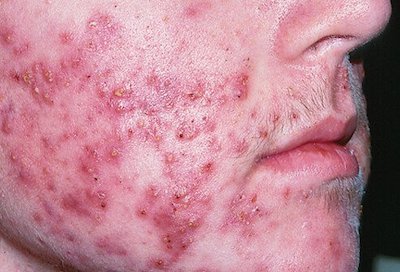

Nice post Sydel.
It has helped solidify my research about acne.
Thanks.
I’m glad I could help!